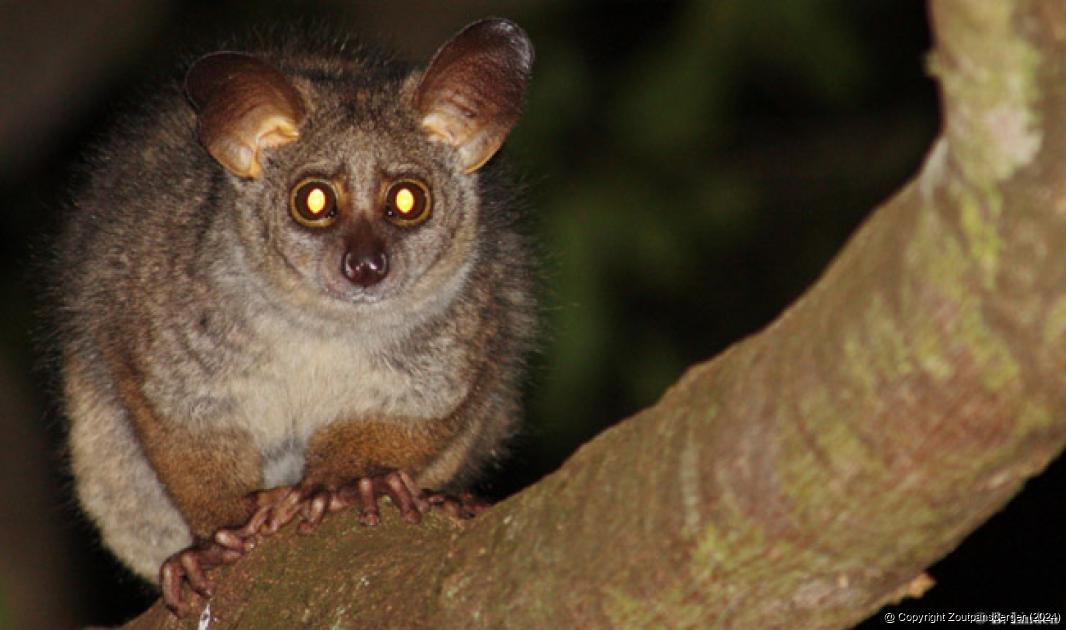

ADVERTISEMENT:

A greater bushbaby (Otolemur crassicaudatus) in a fig tree in the Soutpansberg. Photo: B Linden.
Not the tokoloshe merely a bushbaby
Date: 28 May 2015 By: Andries van Zyl
A recent article in the Zoutpansberger’s sister publication, the Limpopo Mirror, about a villager who claimed to have killed a tokoloshe has environmentalists and nature lovers fuming.
In the 8 May edition of the Limpopo Mirror, Mr Fhulufhedzani Munzhelele of Tshifudi-Mushungwa outside Thohoyandou proudly displayed the dead remains of what he believed to be a tokoloshe that he had killed. The poor animal, however, was not a tokoloshe but just an unfortunate bushbaby.
“For a zoologist or nature enthusiast, there is nothing strange about the creature the community member is holding in his hands in the photo accompanying the article. The animal is neither unknown nor dangerous. The English common name for this animal is the greater galago or greater bushbaby (Otolemur crassicaudatus), the latter name stemming from the baby-like calls the animal makes at night. In TshiVenda, it is known as zelehani. The greater bushbaby uses these calls to communicate with other bushbabies – much like the roar of a lion or a dog’s bark,” said Ms Bibi Linden, local conservationist and PhD researcher.
Linden explained that the bushbaby belongs to the primates, like baboons, monkeys and humans. South Africa is home to two different kinds of bushbabies: the greater bushbaby (the one Mr. Munzhelele chose to kill) and the lesser bushbaby – as the name indicates, the lesser bushbaby is much smaller than the greater bushbaby.
“Bushbabies are active sporadically throughout the night, moving from their daytime resting places at about sunset. They live in small groups of up to six individuals, but generally search for food on their own. The greater bushbaby mainly feeds on fruit and vegetable matter and gum from the sweet thorn, being predominantly vegetarian. It generally does not eat meat or hunt other animals. Although the calls of the bushbaby can be heard frequently in areas where they occur, they are very shy creatures and getting a glimpse of them in the wild is a rare and special occasion,” said Linden
The greater bushbaby can be found in forests, including those along streams and rivers, well-developed woodlands and thickets. Bushbabies spend most of their time in the canopy of trees but do occasionally come to the ground when searching for food. The greater bushbaby mostly moves in the canopy of trees on all four legs, walking or running along branches. When on the ground, they can sometimes be seen hopping on their hind legs, moving in a semi-upright position on two legs only and using their tail for balance. “The greater bushbaby is increasingly threatened by the loss of forest and woodland habitat in the country,” said Linden.
Linden appealed to people to refrain from killing or persecuting these fascinating animals. “They pose no threat to humans whatsoever and there is absolutely no need to be afraid of them. As every living creature on the planet, bushbabies play an important role in nature and they are part of South Africa’s amazing natural heritage which we should all be proud of and help protect for the generations to come,” Linden said. She added that the complete lack of understanding of the character of this animal, particularly fuelling fear that this harmless species poses a threat to people, can result in detrimental impacts on populations of this gentle primate, similar to the unfounded belief concerning the medicinal properties of rhino horn.
Viewed: 2483
|
|
Tweet |

-

MMSEZ now also looking at nuclear power
19 April 2024 By Andries van Zyl -

Woede ná R524 nog ‘n lewe eis
19 April 2024 By Andries van Zyl -

T20-spanne hervat liga ná kort breek
19 April 2024 By Andries van Zyl -

Vrae oor waarom Vhembe so sloer?
18 April 2024 By Andries van Zyl -

Border fence contractors lose appeal
18 April 2024

Andries van Zyl
Andries joined the Zoutpansberger and Limpopo Mirror in April 1993 as a darkroom assistant. Within a couple of months he moved over to the production side of the newspaper and eventually doubled as a reporter. In 1995 he left the newspaper group and travelled overseas for a couple of months. In 1996, Andries rejoined the Zoutpansberger as a reporter. In August 2002, he was appointed as News Editor of the Zoutpansberger, a position he holds until today.

More photos...

ADVERTISEMENT


-

Park development leaves residents puzzled
22 March 2024 By Andries van Zyl -

Local para-athletes shine at SA Champs
05 April 2024 -

Former Triegie’s acting career taking off
12 April 2024 By Karla van Zyl -

Epic finish for local cycling duo
29 March 2024 By Andries van Zyl -

What next Vhembe!
22 March 2024 By Andries van Zyl

ADVERTISEMENT:


ADVERTISEMENT



